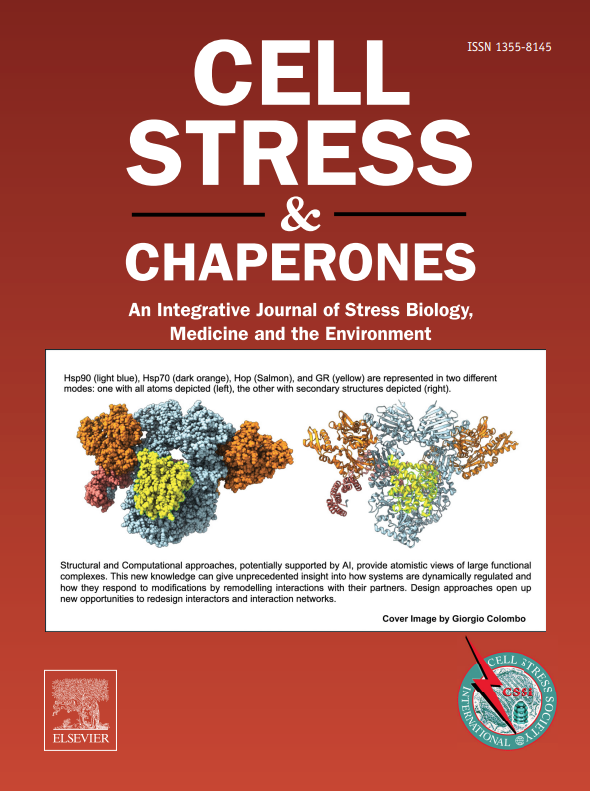Increased intracellular stress responses and decreased KLF2 in adult patients with atopic dermatitis
IF 3.2
3区 生物学
Q3 CELL BIOLOGY
引用次数: 0
Abstract
Atopic dermatitis (AD) is prone to exacerbations in response to various triggering factors and flare-ups after remission. We searched for molecules associated with relapse/exacerbation of AD among molecules with altered gene expression in the skin of patients with AD. Microarray analyses were performed on lesional and nonlesional skin of adolescent or adult patients with recalcitrant AD and healthy controls. Five chaperones involved in intracellular stress responses, namely heat shock protein family A (Hsp70) member 9 (HSPA9), heat shock protein 90 beta family member 1 (HSP90B1), calnexin (CANX), malectin (MLEC; endoplasmic reticulum-associated degradation), and heat shock protein family D (Hsp60) member 1 (HSPD1), were consistently upregulated in involved and uninvolved skin of patients with AD. Damage-associated molecular patterns were upregulated in involved skin. KLF transcription factor 2 (KLF2) was decreased in involved skin and exhibited a decreasing trend in uninvolved skin of patients with AD. CD4(+)/CD8(+) double-positive cells (1.4% of T cells) were detected in lesions with declined KLF2 levels. WNT inhibitory factor 1 (WIF1) was downregulated in involved skin. Prolactin-induced protein was upregulated in only uninvolved skin of patients with AD. We found increased intracellular stress responses and decreased expression of KLF2 in the skin of patients with AD. Multifactorial genetic diseases, such as asthma, inflammatory bowel disease, type 2 diabetes, and rheumatoid arthritis, are associated with intracellular stress. Intracellular abnormalities may also be responsible for AD. Further research on AD may incorporate enhanced intracellular stress response and the decreased expression of KLF2 into the mechanism underlying AD.
成人特应性皮炎患者细胞内应激反应增加,KLF2降低。
特应性皮炎(AD)在缓解后容易因各种触发因素而恶化和发作。我们在阿尔茨海默病患者皮肤基因表达改变的分子中寻找与阿尔茨海默病复发/加重相关的分子。对青少年或成人顽固性AD患者和健康对照者的病变和非病变皮肤进行微阵列分析。参与细胞内应激反应的5种伴侣蛋白,即热休克蛋白家族A (Hsp70) 9号成员(HSPA9)、热休克蛋白90 β家族1号成员(HSP90B1)、calnexin (CANX)、malectin (MLEC);内质网相关降解)和热休克蛋白家族D (Hsp60)成员1 (HSPD1)在AD患者的受累和非受累皮肤中一致上调。损伤相关的分子模式在受累皮肤中上调。KLF转录因子2 (KLF2)在AD患者受累皮肤中下降,在未受累皮肤中呈下降趋势。在KLF2水平下降的病变中检测到CD4(+)/CD8(+)双阳性细胞(占T细胞的1.4%)。WNT抑制因子1 (WIF1)在受累皮肤中下调。催乳素诱导蛋白仅在AD患者的非相关皮肤中上调。我们发现AD患者皮肤细胞内应激反应增加,KLF2表达降低。多因素遗传疾病,如哮喘、炎症性肠病、2型糖尿病和类风湿关节炎,都与细胞内应激有关。细胞内异常也可能导致AD。对AD的进一步研究可能将细胞内应激反应增强和KLF2表达降低纳入AD的机制。
本文章由计算机程序翻译,如有差异,请以英文原文为准。
求助全文
约1分钟内获得全文
求助全文
来源期刊

Cell Stress & Chaperones
生物-细胞生物学
CiteScore
7.60
自引率
2.60%
发文量
59
审稿时长
6-12 weeks
期刊介绍:
Cell Stress and Chaperones is an integrative journal that bridges the gap between laboratory model systems and natural populations. The journal captures the eclectic spirit of the cellular stress response field in a single, concentrated source of current information. Major emphasis is placed on the effects of climate change on individual species in the natural environment and their capacity to adapt. This emphasis expands our focus on stress biology and medicine by linking climate change effects to research on cellular stress responses of animals, micro-organisms and plants.
 求助内容:
求助内容: 应助结果提醒方式:
应助结果提醒方式:


